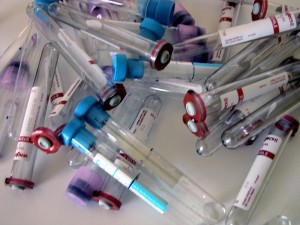The Huffington Post published a story last week titled “Last Menstrual Cycle Could Be Predicted With New Model”. The story stated that a research study had just been published about a new method for predicting the end of menstruation in which researchers developed a formula for using the levels of two hormones, estradiol and follicle stimulating hormone (abbreviated FSH), to make this estimate. This “new method for predicting a woman’s last menstrual cycle could have broader implications for menopausal women’s health”. Since “in the year leading up to the final menstrual period, women are met with faster bone loss and a greater risk of heart disease”, if the end of menstruation could be predicted, medical monitoring and interventions would become possibilities. The research was also reported as news on the medical website Medscape.
Research results are often reported as news stories, as though these results are facts. However, “dog bites man” and “man bites dog” are facts, but research results are not facts in the same way. They are “evidence” that most often must be evaluated, understood, and put into the context of many other studies. There could very well be disagreement about whether a study’s methods really did accurately make a point, or whether the conclusions the researchers drew from their work were justified. Sadly, it happens all too often that research does not make the point that the headlines claim.
Here, we have a study by a respected researcher at a major institution, UCLA, funded by a grant from the National Institutes of Health and other prestigious grantors. However, we do not have the information with which to understand what the researchers actually did. UCLA issued a press release which states that the study “suggests” a way to predict the final period. The Medscape article states that “A new model MAY [my emphasis] help physicians determine how far a woman is from her final menstrual period”.
Suggests? May? I have no idea what this means. As a researcher, I want to look at the published article to see what was actually done. However, the publisher does not make a free copy of the article available. Anyone who wants to look at the published article—a researcher or an informed consumer—would need to pay the publisher $37.00 to access this 20-page article for one day. Predicting the last menstrual period from hormone levels, which is what is claimed, is something other researchers have tried but failed to do, so how these researchers worked with the difficult problems is an important question.
Assume for a moment that the model was a big success, and it did predict the last menstrual period. The idea that this has important implications for women’s health is stated as though it were another fact. However, this is not a fact; this is a complicated and controversial area. Bone density does decrease in the years surrounding menopause, but professionals disagree about how big an effect this has on bone disease. For example, current guidelines recommend testing bone density beginning at age 65, 15 years after the average age of menopause, because this is when the fracture rate has significantly increased. Heart disease risk factors may increase on average in the years surrounding menopause, but professionals disagree about whether menopause is important compared with other factors associated with aging.
Assume for a moment that bone disease really is an important negative health consequence of menopause. Whether interventions would be found that must be started in the year or two before menopause is another speculation. Such interventions might be found or might not. Predicting the last menstrual period, even if the claim is valid that a method to do so has been found, is a long way from preventing disease.
The medical satirist Andrew Vickers wrote an article called “News On Cancer Drug Fails to Raise False Hopes”, which begins: “A recent article on a novel cancer therapy has rocked the newspaper industry by giving a balanced and cautious review of an early-phase trial”. Satirists make extreme statements to make a point. Media reports are often written to sound definite and to portray a study as really important. A cautious approach to medical news is to withhold judgment unless the methodology of the study is clear and the context of the study is understood.


